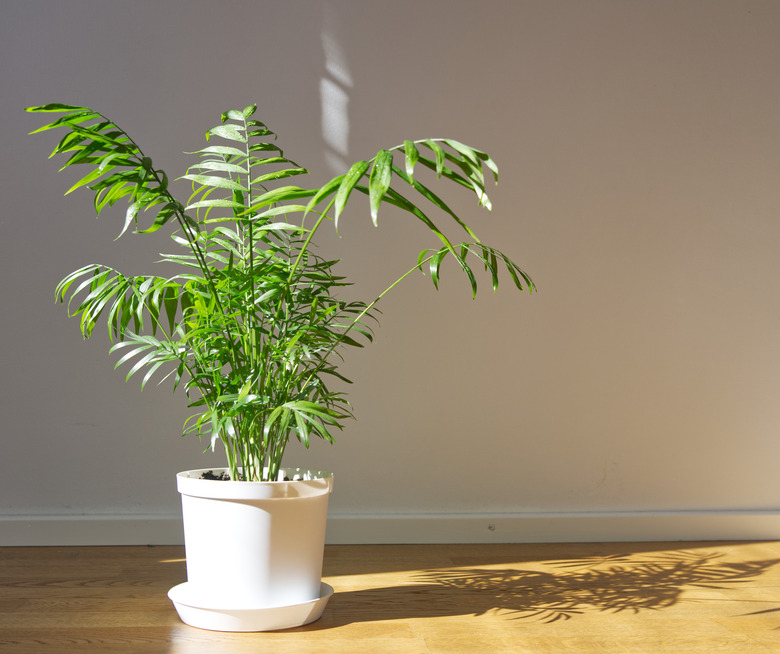How To Care For A Palm Plant
We may receive a commission on purchases made from links.
Palms (Arecaceae) abound for indoor spaces, and they're similar in how they like to be treated. These vibrant, leafy tropical plants are big fans of well-drained soil, sunlight, mist and warm temperatures. These plants don't take a lot of work, but similar to children and pets, they have needs that must be met if they are to thrive.
Sunlight: Direct or Indirect?
Sunlight: Direct or Indirect?
One mistake a lot of plant owners make is in thinking that sunlight is good for all plants, especially when they're tropical, but this is often untrue. Coconut palms (Cocos nucifera, USDA zones 10-12) need direct sunlight for as much as eight hours daily. However, bamboo palm (Chamaedorea microspadix, zones 8-11), cat palm (Chamaedorea cataractarum, zones 9b-11), Chinese fan palm (Livistona chinensis, zones 9-11), date palm (Phoenix canariensis, zones 9-11) and parlor palm (Chamaedorea elegans, zones 10-12) all prefer indirect sunlight, and direct sunlight can scorch their fronds. The majesty palm (Ravenea rivularis, zones 10-11) is somewhere in between. It likes bright but indirect sunlight, as harsh afternoon light can burn its leaves.
Think about tropical jungles, where these plants grow. Most of the plants grow under a thick canopy of other trees, so they're naturally getting filtered light and not direct sunlight. Most palms grow faster in indirect light.
Still, all palms are not equal, so find out what sunlight level is appropriate for your palm. If it's getting scorched fronds — brown spots on its leaves — it may need a new spot in your home, so move it around and see how it reacts to the light in various parts of your space. You might be surprised by how much moving it 10 feet across a room can improve its health. To keep your palms growing evenly, turn them 180 degrees once a month so sunlight can reach the plant evenly over the course of the year.
Water and Humidity Requirements
Water and Humidity Requirements
These plants are at home in jungle climates and tropical places, where humidity is high and rain can be infrequent. Most palms want to dry out between waterings, but this varies dramatically among species. The cat palm wants the top 25 percent or so of its soil to be dry between waterings, whereas the coconut palm wants 75 percent of its soil to dry out before more water is added.
The majesty palm, being all regal and high maintenance, wants its soil constantly moist but never waterlogged or completely dry. If it has yellow leaves, it may be getting too much water or the roots sit in water often. Brown leaves say the opposite, so water it.
All palms, however, enjoy a misting. Keep a spray bottle nearby and as you tidy or dust or just wander past, give your palms a spritz now and then. A few times weekly will keep them happy and help them fend off insects.
Feeding Your Palm Plants
Feeding Your Palm Plants
Fertilization needs vary among species, so you'll need to know your plant type before you give it fertilizer. Consider a palm-specific fertilizer. Many only want fertilizing in the spring. Cat palms, date palms and Chinese fan palms want monthly fertilizer in the spring and summer and a rest period through cooler months, but dilute fertilizer to half its strength when feeding. A coconut palm wants fertilizer in the spring and summer but just one application in each of these seasons.
Majesty palms are fussy and need a fertilizer with iron to be fed every two months during the growing season and not at all in the winter. Add a pinch of Epsom salt once a month for its required magnesium. In the cold season, leave it alone and just water it.
Palm Plant Temperature Requirements
Palm Plant Temperature Requirements
Whatever the type of palm, drafts from air conditioners and windows can be problematic. Keep them in a draft-free spot for a consistent climate.
Some, like the majesty, can tolerate climates as low as 40 degrees Fahrenheit, but the sweet spot for palms tends to be 65 to 80 F. The direct-sun-loving coconut palm goes dormant below 60 F and prefers a true tropical climate with temperatures between 70 and 90 F.
References
- Bloomscape: Palm Care
- Miracle-Gro: How to Grow Palms Indoors
- Missouri Botanical Garden: Cocos nucifera
- Missouri Botanical Garden: Chamaedorea microspadix
- Clemson Cooperative Extension: Indoor Palms
- Missouri Botanical Garden: Phoenix canariensis
- Missouri Botanical Garden: Chamaedorea elegans
- Cal Poly Urban Forest Ecoeyetem Institute: Chinese Fan Palm
- Cal Poly Urban Forest Ecosystem Institute: Majesty Palm
